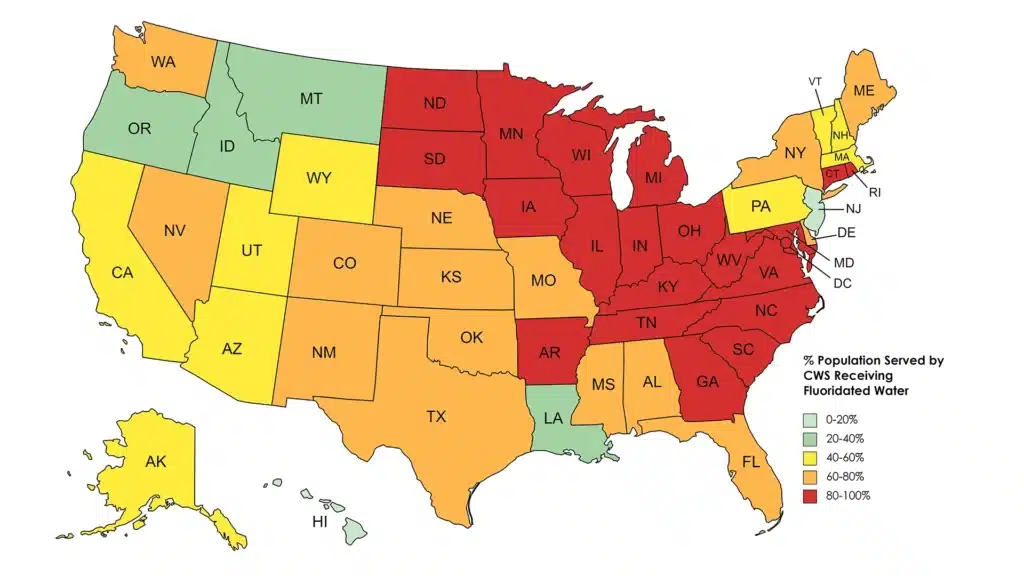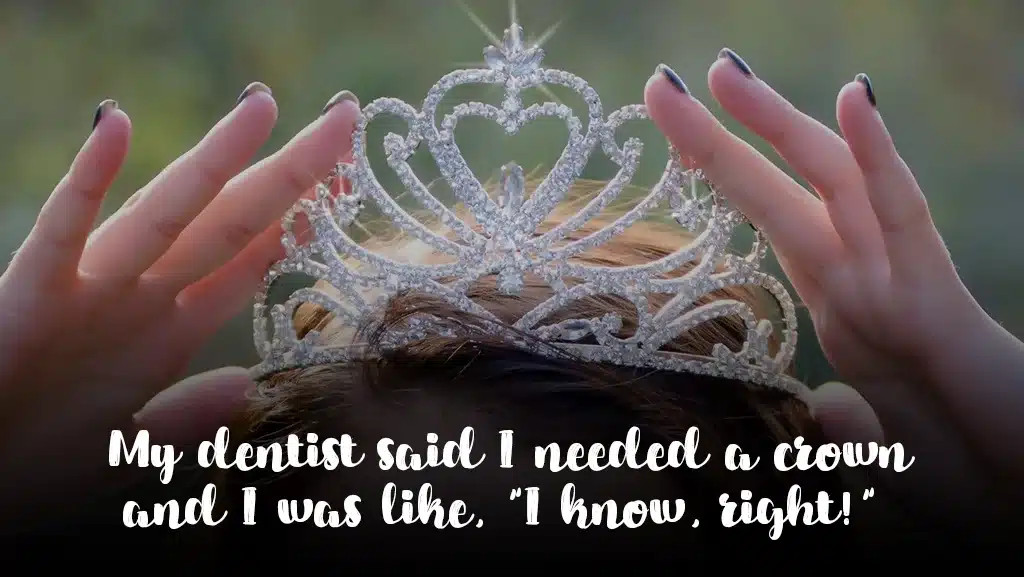Do a Google search on the risks and benefits of fluoride and you will be confronted with more scientific research and armchair opinions that are harder to take in than the recommended 8 glasses of water a day. In my opinion, one of the most compelling things about the history of fluoridation (in the U.S.) is how it became a public health measure mimicking a natural phenomenon.
There Must Be Something In the Water
In the early 1900’s, a dentist practicing in Colorado, Dr. Frederick McKay, embarked on a 30-year research study to uncover the causes of stained teeth that were prevalent in his area, known locally as the “Colorado brown stain.” He found similar results in other states, including Texas, where they were actually calling them “Texas teeth.” G.V. Black joined McKay in Colorado to study “dental mottling” (what they were calling it) and the first of their papers noted that the mottling didn’t seem to increase the susceptibility of tooth decay. In fact, despite all of the staining, the teeth shared an absence of decay and they attributed the staining to something in the water.
In 1931, that something was identified as fluoride. Fluoride is a mineral (not a chemical) that we now know occurs naturally in most water supplies at varying levels. Enter the Public Health Service and a new goal to find the right balance between preventing decay and preventing staining (today known as dental fluorosis).
Dr. H. Trendley Dean furthered the exploration by hypothesizing a connection between communities with higher levels of natural fluoride in their water sources having lower rates of dental cavities. The hypothesis that fluoride, when present in optimal levels, may in fact contribute to dental health by reducing the incidence of cavities led Dr. Dean, along with his colleagues, to conduct some very interesting studies in the 30s and 40s.
Here’s a fun fact to impress your friends: Grand Rapids, Michigan was the first U.S. city to add fluoride to its public water supply.
In January, 1945, Grand Rapids became the first city to intentionally add fluoride to its water supply as part of a controlled study to test the effectiveness of water fluoridation in preventing dental caries. Nearby Muskegon served as a control group with non-fluoridated water. Intended to run 10 to 15 years, the Results Pertaining to the Eleventh Year of Fluoridation showed that in all studies a reduction of 60-65% in the prevalence of caries in permanent teeth of children born subsequent to the change in water supply.
In June of that same year, 1945, Newburgh, NY began fluoridating its water supply with nearby Kingston serving as the control group. The Newburg-Kingston Caries Fluorine Study published findings after three years, but lasted for a decade as well, supporting and reinforcing earlier research. After ten years, the children of Newburgh had 58% less decay than those in non-fluoridated Kingston. It was noted that the greatest benefits were obtained by children who were exposed to fluoridated water since birth.
As evidence supporting fluoridation accumulated, it’s not really much of a surprise that more communities took action to adjust their own public water supplies. Over the last several years, fluoridation has decreased the incidence of cavities from 20-40% in children and 15-35% in adults. This number has actually gone down, but we can infer that this is also due to improved dental hygiene and an increase in the use of fluoride toothpaste.
Fluoridation is the modern process of adjusting the natural concentration to the optimum ratio, a ratio which has been determined to be one part of fluoride to a million parts water.
Fluoride protects teeth in two ways. For children who are in the process of forming teeth, fluoride is ingested through food and water and literally becomes part of the tooth structure. Fluoride applied topically (by your dentist or hygienist) and using fluoride-enhanced toothpastes and rinses strengthens teeth that have already formed.
Percentage of states’ population on community water systems receiving fluoridated water in 2020
Currently, more than 200 million Americans live in fluoridated communities. The Percentage of US population on CWS receiving fluoridated water in 2020 is 72.7%, with Washington, DC and Kentucky coming in at 100% and 99.9% respectively while Hawaii (8.5%) and New Jersey (16.1%) coming in at the bottom of the list.

The Public Health Service estimates that every dollar spent for community fluoridation saves about $50 in dental bills. In fact, the ADA notes that “An individual can have a lifetime of fluoridated water for less than the cost of one dental filling.”
Cancer and Heart Disease and Lower IQs, Oh My!
These days it seems like you cant fly on a plane, enjoy a diet coke, talk on a cell phone, reheat your leftover kung pao chicken in a microwave, etc., without fearing they will all eventually cause cancer.
As for fluoride concerns, in 2011, a U.S. study approved by the National Cancer Institute found no link between fluoride and bone cancer. In 2014, a New Zealand study concluded that no link exists between fluoride and lower IQ’s. And according to the American Heart Association, “No evidence exists that adjusting the fluoride content of public water supplies to a level of about one part per million has any harmful effect on the cardiovascular system.”
Anti-fluoride advocates claim (against the evidence) that fluoridation is unsafe, ineffective, and represents a violation of personal freedom. This is compounded by a recent Harvard study used by anti-fluoride activists to try and argue the dangers of fluoride, which has been shared on social media with the same fervor as those ‘People of Walmart’ images.
However, that often cited study is not an actual study, but rather a review of prior research and those research studies included did not involve water fluoridation programs. Most of the studies were conducted in China (though one was conducted in Iran) which has a limited fluoridation program.
Because most of the studies cited are outside of the U.S., the standards for recommended levels of fluoride are vastly different – sometimes more than triple.
The review also failed to rule out other variables such as arsenic exposure, burning high fluoride coal in the home, and ingesting contaminated grains. In fact, the actual findings of the study don’t show that there is any risk from public water fluoridation.
Comparing Apples or Oranges to Ironing Boards
Everyone agrees that excessive fluoride can cause fluorosis. However, while pitted and stained teeth might not make your smile pretty, it does not affect the integrity and function of your teeth. Some countries have extremely high, natural levels of fluoride; case in point being India, where they are not adjusted to U.S. standards. Keep in mind that fluorosis can be found in areas/countries that do not fluoridate their water. Norwegian children still exhibit the telltale stains and their water supplies are fluoride free.
Most experts agree that fluorosis in young children can also be the result of swallowing a fluoride toothpaste, which contains a concentration 1,000 times higher than the levels in fluoridated water. This is the reason for those warning labels on the tubes, and another example of why parents should be supervising their children’s tooth brushing routine!
The danger comes from comparing apples and oranges, or the United States to China or Italy. Italy has not invested in a public water fluoridation program, primarily because drinking bottled water is a well-established practice there, not because they disagree with public fluoridation programs or advocate for personal freedom. Many European countries are obtaining their fluoride through salt. In fact, an estimated 70 million Europeans intentionally consume fluoridated salt or milk.
Another example of ‘junk science’ is the assertion that some states with a public fluoridation program have higher decay rates than those where fluoridation is less common. The reality is, while water fluoridation plays a key role in decay prevention, there are other factors, including socioeconomic, that influence dental health. Research confirms that low-income populations are more at risk for decay than upper income Americans. For example, if we compared the residents of West Virginia with those living in Connecticut, they are reached equally at 90-91% with fluoridated water. However, the percentage of West Virginians living below the poverty line is nearly double that in Connecticut. Obviously income status shapes how often a person visits a dentist, as well as diet, nutrition and other habits. Fluoridated water is a good start at prevention, but just because it’s available, doesn’t mean it’s a panacea to the problems of poverty.
Activists have also tried to align fluoride as a toxic by-product of fertilizer. The truth is that fluoride is extracted from phosphate rock, and so is phosphoric acid (found in Coke and Pepsi products). Neither come from fertilizer.
Exercising the First Amendment
The decision on whether and how to adjust fluoride is made at the municipal and local government, not the Federal, level. This is why some communities add fluoride and others do not. The primary objection of the activist groups is they view it as an imposition on personal freedom, seeing fluoridation as involuntary medication. The anti-fluoride movement propose that the community distributes free fluoride tablets to parents who wish to give them to their children. However, most parents (irrespective of demographic or income level) are not motivated to administer the 4,000+ doses needed from birth through age 12. The people who need fluoridation the most – the children – do not vote.
Here in Maine, 79.5% of our population is served by Community Water Sources receiving fluoridated water. If you happen to be living outside of that, for example when your home draws from well water, there are some protocols and options to consider for ensuring an adequate fluoride intake. There are fluoride tablets or drops, as well as bottled water options, though it has to be a consistent and concerted effort. If you’re in that situation, it’s best to consult with your dentist and/or pediatrician to determine the best course of action for you and your child. At the end of the day, community-level water fluoridation remains the most effective and equitable way to prevent tooth decay, particularly in populations with limited access to dental care or resources.
For additional information about fluoridation, I highly recommend the ADA’s Fluoridation FAQs which provides answers to common questions based on generally accepted, peer-reviewed, scientific evidence.
Your other option is to go back to Google where you’ll find a variety of natural alternatives to “reverse tooth decay,” including eating spinach salad, where sprinkling a little kelp on top is supposed to help with any radiation poisoning you may be experiencing. Of course, it was once thought that spending the afternoon with a couple of leeches attached to your arm could cure an array of things from fevers to flatulence. Actually, my wife might be willing for me to try leech therapy, if only for the latter issue.

For the record, spinach and kelp do contain low levels of fluoride. To paint the picture, on average spinach has around 0.05-0.1 milligrams of fluoride per 100 grams. Kelp is a little higher between 0.8-1.5 milligrams of fluoride per gram. That’s a lot of spinach salad to eat, which brings me right back to my wife sending me off to try leech therapy.




